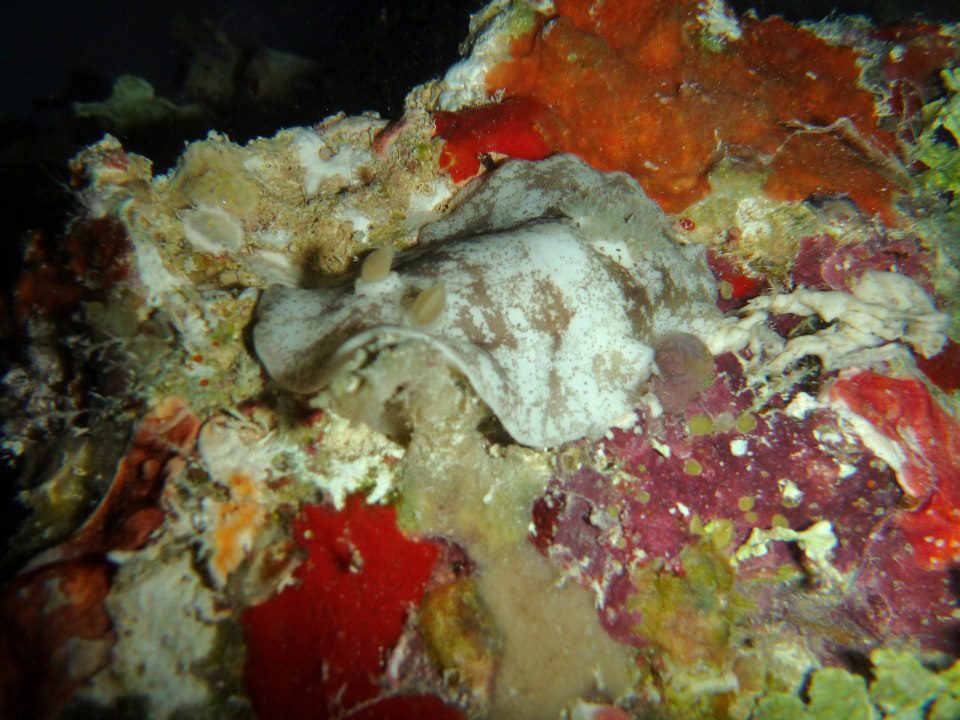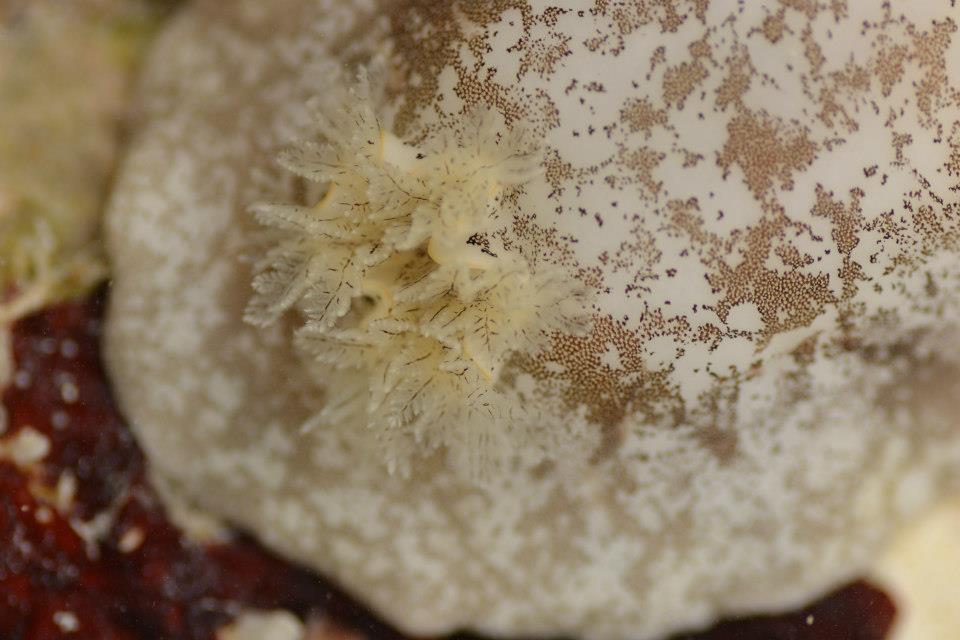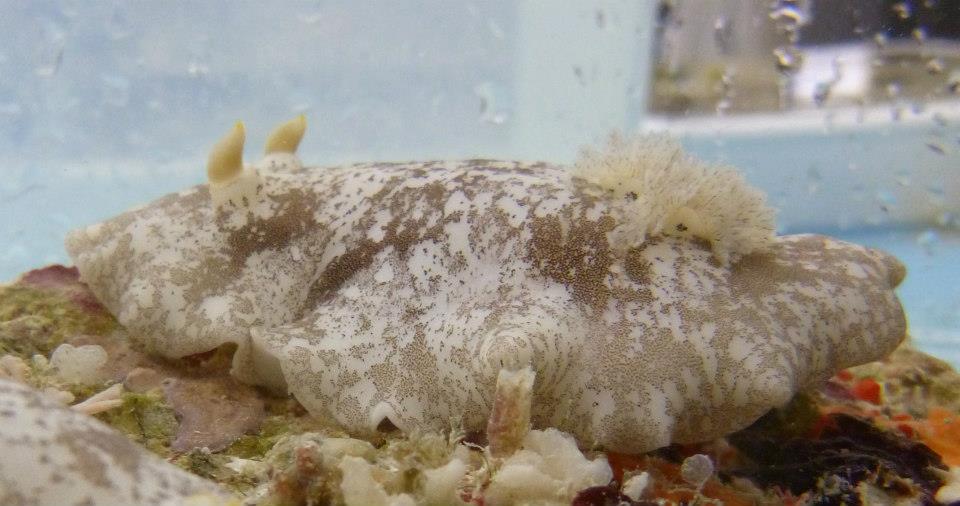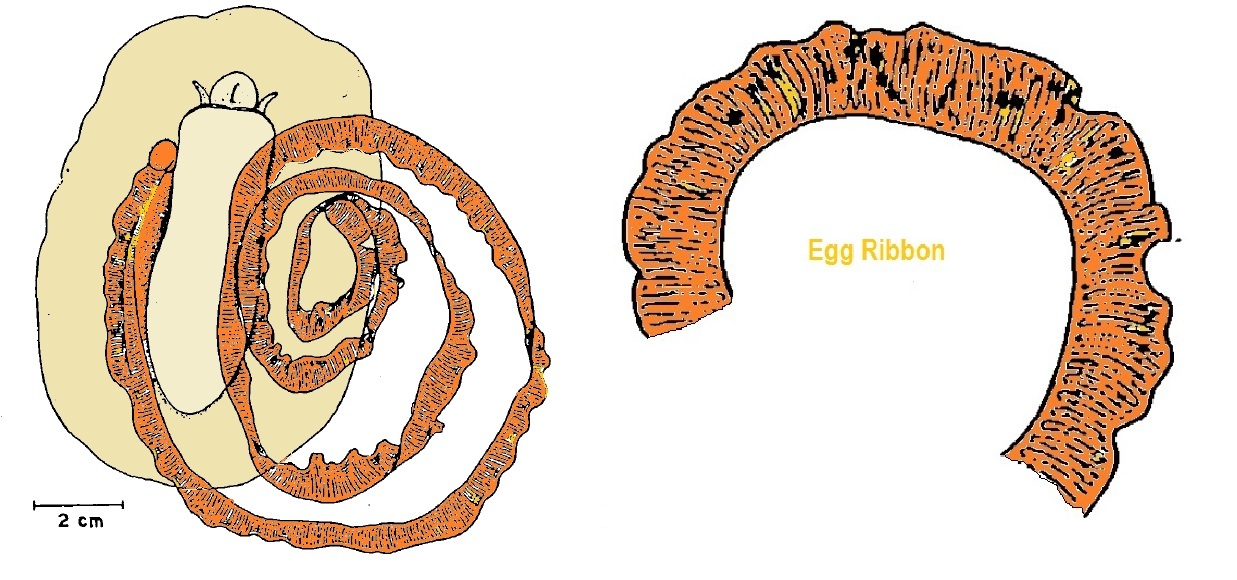Life History & Behaviour
Feeding
At present, the diet of Platydoris scabra is not well understood. However, most cryptobranch dorids are carnivores as exemplified by Platydoris argo, which predominantly feeds on demosponges and macrobenthic invertebrates (Megina et al. 2002).
Platydoris scabra have an anterior mouth which opens into a buccal cavity. Within this cavity is a hard feeding apparatus known as a radula. The radula is a tongue like mouth part which has lateral rows containing thousands of tiny chitinous teeth (Ruppert et al. 2004). Platydoris scabra use their radula to rasp off pieces of food and to direct the food towards the digestive tract. Protractor muscles are used to force the radula to protrude slightly from the mouth, positioning it against the substrate. The retractor muscles then pull the radula backward, during which time the substrata is scraped by the radula teeth. The radular protractor and retractor muscles work antagonistically to move the radula backwards and forwards, gradually rasping away at the substratum. The food particles are caught in the chitinous teeth and these particles are moved towards to esophagus in a conveyer-belt like motion. The specific number of teeth and the morphology, shape and dentition of each type of tooth is a defining characteristic of Platydoris scabra. For more information about teeth composition in Platydoris scabra, refer to the Anatomy and Physiology link.

Photograph of the underside of a piece of coral rubble including Platydoris scabra and various brightly coloured invertebrates.
Photo taken by Tahsha Say at Heron Island.
Respiration
Respiration in Platydoris scabra is conducted by complex tripinnate gills, which extract oxygen from the seawater. These gills can be quickly retracted into a branchial pocket as a defence mechanism to protect their gills from predation. Although respiration in Platydoris scabra is not well understood, respiration has been extensively studied on the dorid nudibranch Archidoris pseudoargus (Potts 1981). This species also has complex tripinnate gills which encircle the anus therefore, respiration is likely to be similar in Platydoris scabra.
Gas exchange occurs through a counter-current exchange system which is common among aquatic organisms as this enables the efficient uptake of oxygen. The gills of Platydoris scabra have been modified, and the elaborate branchial vessels enable highly efficient extraction of oxygen from the surrounding water. Unoxygenated blood from organs such as the kidney, digestive gland and gonads are supplied to the pinnules by an afferent branchial vessel. Pinnules prove the main source of ciliation for the respiratory currents throughout the gills and also enhance the efficiency of gas exchange (Potts 1981). An efferent branchial vessel transfers oxygenated blood from the gills, to the heart.

Above is a photograph of Platydoris scabra's gills taken at Heron Island by Tahsha Say.
Locomotion
Platydoris scabra crawls along the sea floor using a flat, flexible “foot” which is located beneath the mantle. During locomotion, the thick, encircling outer band of the mantle remains in contact with the substrate. However, the inner strip tissue of the foot only comes into contact with the sea floor during the waves of muscular contractions used to enable their crawling movement. Platydoris scabra also secretes mucus from their foot to aid in locomotion via muscular waves.

Photograph of Platydoris scabra crawling over a piece of rubble
(photo taken by Tahsha Say at Heron Island).
Reproduction
Mating
Platydoris scabra’s breeding season is believed to extend from June to August (Soliman 1978). They only have a short life span, and reach sexual maturity at a young age. Platydoris scabra are hermaphroditic however, two mature adults are necessary for a successful mating event to occur. Mating typically occurs when two adults position head to tail (as illustrated below) and the penises are inserted into the female openings reciprocally (Karlsson & Haase 2002). For a more detailed explanation of copulation in Platydoris scabra refer to the Anatomy and Physiology link.

Photograph of two Platydoris scabra individuals positioned head to tail, illustrating
the behaviour exhibited during mating (photo taken by Tahsha Say).
Oviposition
Oviposition begins 8-10 days after mating (Soliman 1978). According to Johnson and Boucher (1983), Platydoris scabra lays an orange-yellow egg ribbon in a counter-clockwise direction. The ova (80 μm diameter) are bright orange and occur within individual capsules (100 μm). The egg ribbon is laid from the crescentic aperture of the oviduct and there are approximately 210 ova per 1 mm of egg ribbon (Soliman 1978). The orange spawn mass consisting of a coil of four whorls acquires a sticky nature. This enables the adults to stick the egg ribbon edgewise onto the substrata using pressure from their foot. Larvae hatch as free-swimming veligers in 5 days (Johnson & Boucher 1983) and swim upwards towards the surface of the water. Larvae spend approximately 8 days in the plankton before finally settling on to the sea floor and undergoing metamorphosis (Soliman 1978). Larval settlement onto the benthos is typically initiated by the detection of environmental cues which signal that a location is a suitable settlement site (Hadfield & Paul 2001).

|
Ventral view of Platydoris scabra during egg laying, with part of the egg ribbon enlarged (adapted from Soliman 1978).
|
|